SUBARU LEGACY 1999 Service Repair Manual
Manufacturer: SUBARU, Model Year: 1999, Model line: LEGACY, Model: SUBARU LEGACY 1999Pages: 1456, PDF Size: 59.93 MB
Page 561 of 1456

5) Remove control valve body.
CAUTION:
When removing control valve body, be careful
not to interfere with transfer duty solenoid C
wiring.
NOTE:
Be careful because oil flows from valve body.
B3M1037
6) Remove oil strainer.
NOTE:
Be careful because oil flows from oil strainer.
B3M1038A
7) Remove solenoids and duty solenoids.
B3M1039A
(A) Lock-up duty solenoid (Blue)
(B) Low clutch timing solenoid (Gray)
(C) Line pressure duty solenoid (Red)
(D) Shift solenoid 2 (Yellow)
(E) Shift solenoid 1 (Green)
(F) 2-4 brake timing solenoid (Black)
(G) 2-4 brake duty solenoid (Red)
(H) ATF temperature sensor
B: INSTALLATION
1) Install 7 solenoids and ATF temperature sensor.
Tightening torque:
T: 8
±1 N´m (0.8±0.1 kg-m, 5.8±0.7 ft-lb)
B3M1039B
(A) Lock-up duty solenoid (Blue)
(B) Low clutch timing solenoid (Gray)
(C) Line pressure duty solenoid (Red)
(D) Shift solenoid 2 (Yellow)
(E) Shift solenoid 1 (Green)
(F) 2-4 brake timing solenoid (Black)
(G) 2-4 brake duty solenoid (Red)
(H) ATF temperature sensor
2) Install oil strainer.
Tightening torque:
8
±1 N´m (0.8±0.1 kg-m, 5.8±0.7 ft-lb)
B3M1038B
(A) Short bolt
(B) Middle bolt
(C) Long bolt
35
[W4B0]3-2SERVICE PROCEDURE
4. Shift Solenoid, Duty Solenoid and Valve
Page 562 of 1456
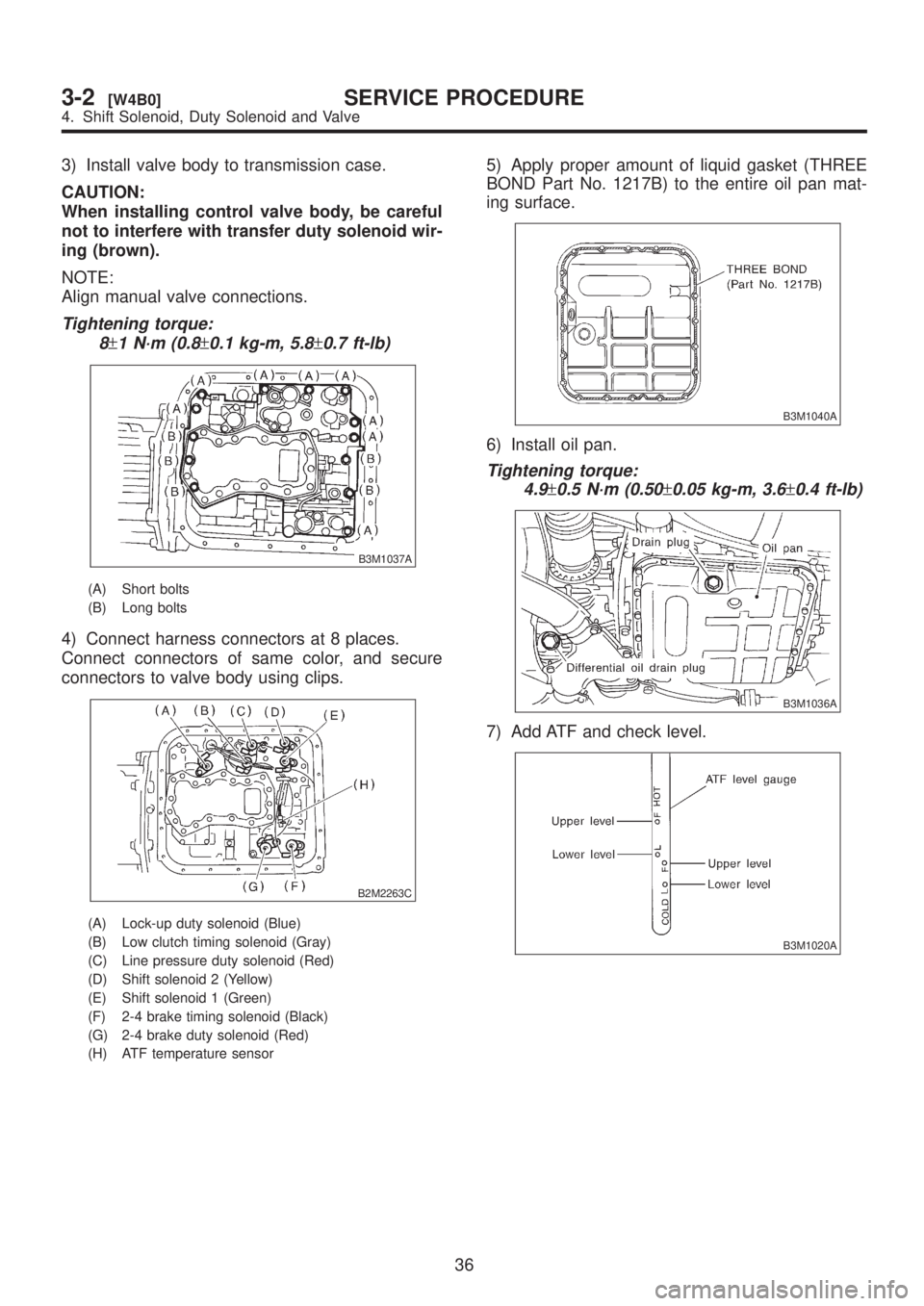
3) Install valve body to transmission case.
CAUTION:
When installing control valve body, be careful
not to interfere with transfer duty solenoid wir-
ing (brown).
NOTE:
Align manual valve connections.
Tightening torque:
8
±1 N´m (0.8±0.1 kg-m, 5.8±0.7 ft-lb)
B3M1037A
(A) Short bolts
(B) Long bolts
4) Connect harness connectors at 8 places.
Connect connectors of same color, and secure
connectors to valve body using clips.
B2M2263C
(A) Lock-up duty solenoid (Blue)
(B) Low clutch timing solenoid (Gray)
(C) Line pressure duty solenoid (Red)
(D) Shift solenoid 2 (Yellow)
(E) Shift solenoid 1 (Green)
(F) 2-4 brake timing solenoid (Black)
(G) 2-4 brake duty solenoid (Red)
(H) ATF temperature sensor
5) Apply proper amount of liquid gasket (THREE
BOND Part No. 1217B) to the entire oil pan mat-
ing surface.
B3M1040A
6) Install oil pan.
Tightening torque:
4.9
±0.5 N´m (0.50±0.05 kg-m, 3.6±0.4 ft-lb)
B3M1036A
7) Add ATF and check level.
B3M1020A
36
3-2[W4B0]SERVICE PROCEDURE
4. Shift Solenoid, Duty Solenoid and Valve
Page 563 of 1456
![SUBARU LEGACY 1999 Service Repair Manual 5. Duty Solenoid C and
Transfer Valve Body
A: REMOVAL
1) Remove air intake duct and chamber. (Except
2200 cc California spec. vehicles)
<Ref. to 2-7 [W1A0].>
S6M0007
2) Remove air intake duct and clea SUBARU LEGACY 1999 Service Repair Manual 5. Duty Solenoid C and
Transfer Valve Body
A: REMOVAL
1) Remove air intake duct and chamber. (Except
2200 cc California spec. vehicles)
<Ref. to 2-7 [W1A0].>
S6M0007
2) Remove air intake duct and clea](/img/17/57435/w960_57435-562.png)
5. Duty Solenoid C and
Transfer Valve Body
A: REMOVAL
1) Remove air intake duct and chamber. (Except
2200 cc California spec. vehicles)
S6M0007
2) Remove air intake duct and cleaner case.
(2200 cc California spec. vehicles)
B2M2320
3) Remove pitching stopper.
B3M1042
4) Raise vehicle and drain ATF.
B3M1036A
5) Remove front exhaust pipe and center exhaust
pipe.
Disconnect oxygen sensor connector, and remove
exhaust pipe.
G3M0305
6) Remove propeller shaft.
NOTE:
Before removing propeller shaft, scribe matching
marks on propeller shaft and rear differential cou-
pling.
G3M0782
37
[W5A0]3-2SERVICE PROCEDURE
5. Duty Solenoid C and Transfer Valve Body
Page 564 of 1456
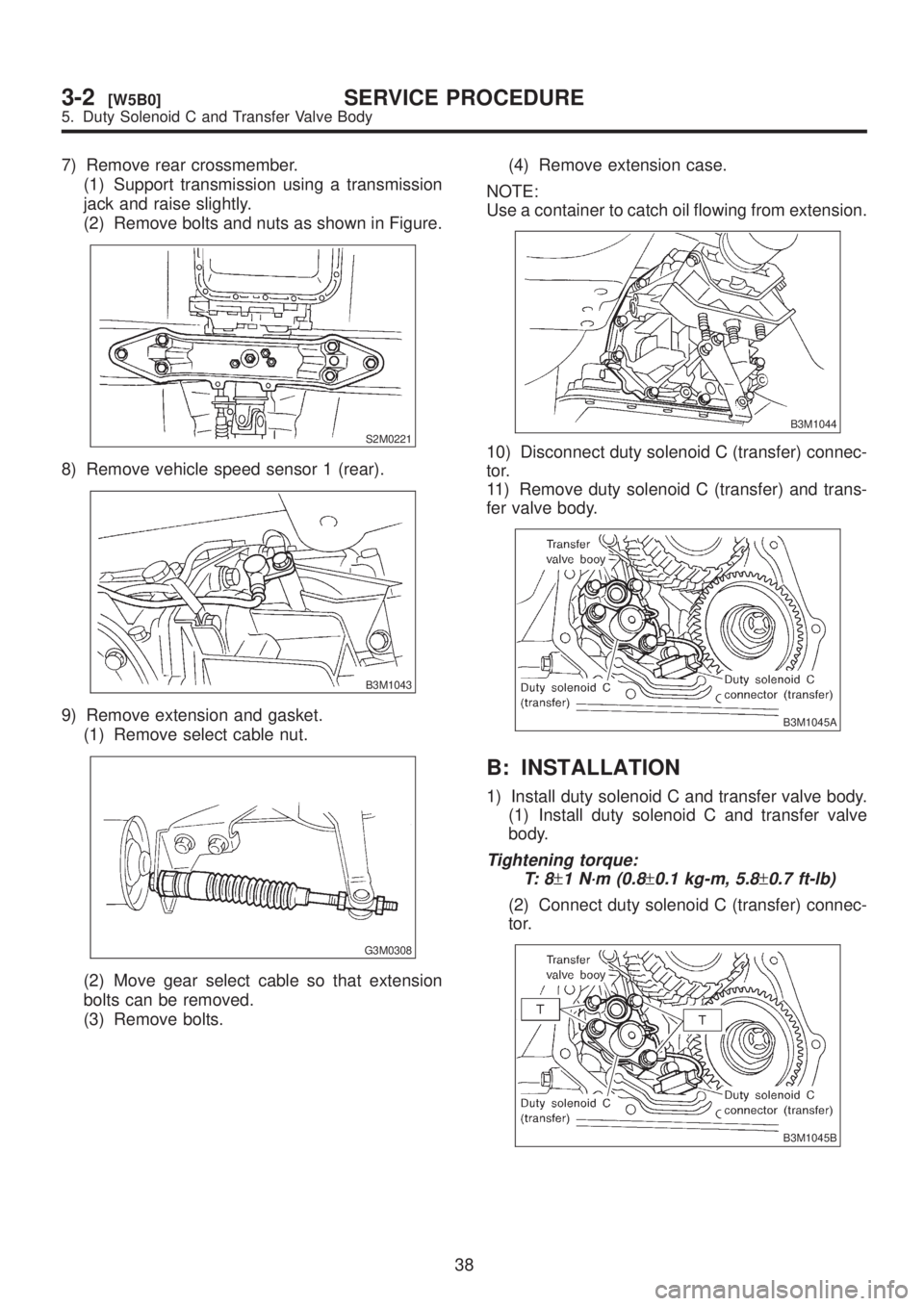
7) Remove rear crossmember.
(1) Support transmission using a transmission
jack and raise slightly.
(2) Remove bolts and nuts as shown in Figure.
S2M0221
8) Remove vehicle speed sensor 1 (rear).
B3M1043
9) Remove extension and gasket.
(1) Remove select cable nut.
G3M0308
(2) Move gear select cable so that extension
bolts can be removed.
(3) Remove bolts.(4) Remove extension case.
NOTE:
Use a container to catch oil flowing from extension.
B3M1044
10) Disconnect duty solenoid C (transfer) connec-
tor.
11) Remove duty solenoid C (transfer) and trans-
fer valve body.
B3M1045A
B: INSTALLATION
1) Install duty solenoid C and transfer valve body.
(1) Install duty solenoid C and transfer valve
body.
Tightening torque:
T: 8
±1 N´m (0.8±0.1 kg-m, 5.8±0.7 ft-lb)
(2) Connect duty solenoid C (transfer) connec-
tor.
B3M1045B
38
3-2[W5B0]SERVICE PROCEDURE
5. Duty Solenoid C and Transfer Valve Body
Page 565 of 1456
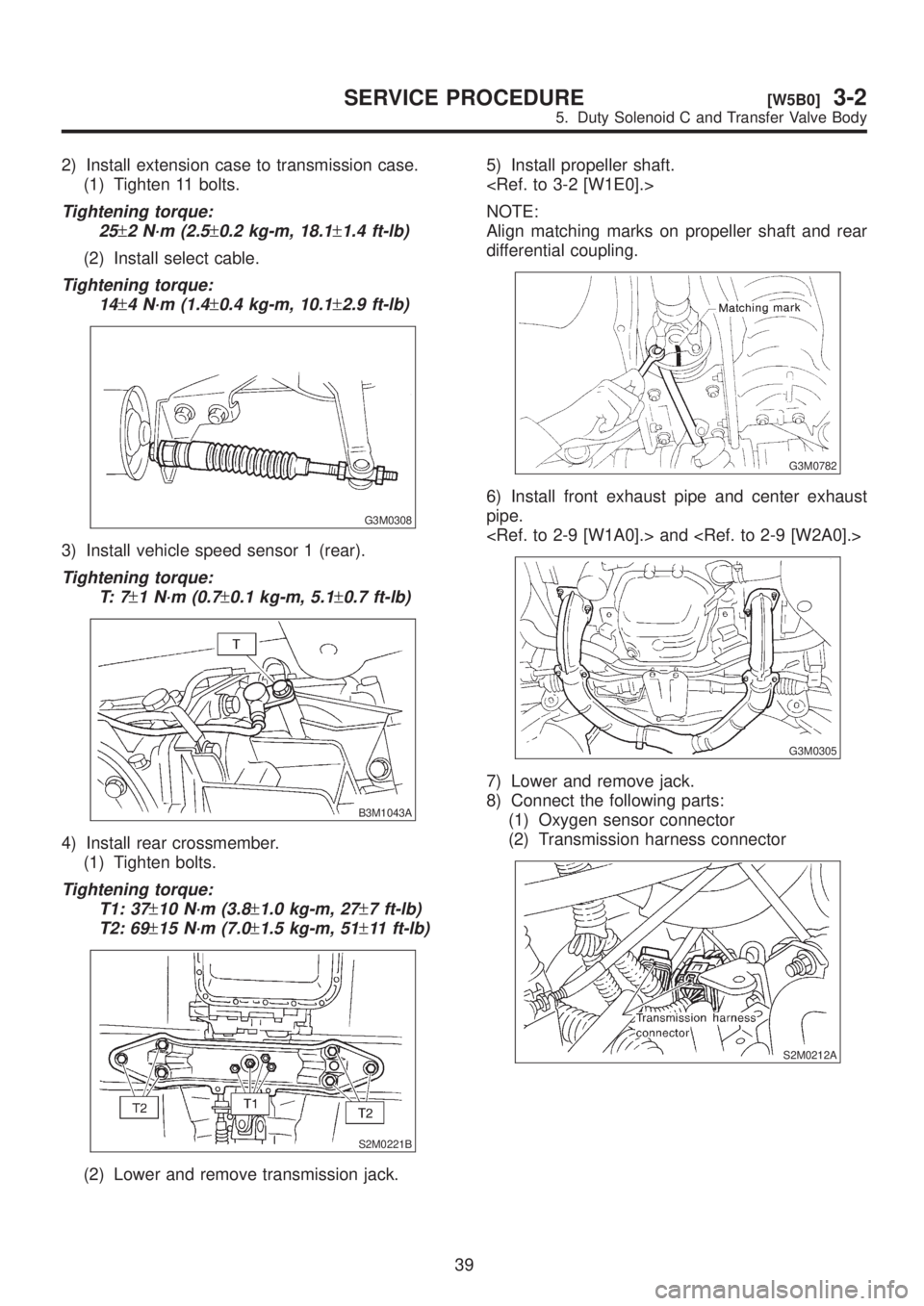
2) Install extension case to transmission case.
(1) Tighten 11 bolts.
Tightening torque:
25
±2 N´m (2.5±0.2 kg-m, 18.1±1.4 ft-lb)
(2) Install select cable.
Tightening torque:
14
±4 N´m (1.4±0.4 kg-m, 10.1±2.9 ft-lb)
G3M0308
3) Install vehicle speed sensor 1 (rear).
Tightening torque:
T: 7
±1 N´m (0.7±0.1 kg-m, 5.1±0.7 ft-lb)
B3M1043A
4) Install rear crossmember.
(1) Tighten bolts.
Tightening torque:
T1: 37
±10 N´m (3.8±1.0 kg-m, 27±7 ft-lb)
T2: 69
±15 N´m (7.0±1.5 kg-m, 51±11 ft-lb)
S2M0221B
(2) Lower and remove transmission jack.5) Install propeller shaft.
NOTE:
Align matching marks on propeller shaft and rear
differential coupling.
G3M0782
6) Install front exhaust pipe and center exhaust
pipe.
G3M0305
7) Lower and remove jack.
8) Connect the following parts:
(1) Oxygen sensor connector
(2) Transmission harness connector
S2M0212A
39
[W5B0]3-2SERVICE PROCEDURE
5. Duty Solenoid C and Transfer Valve Body
Page 566 of 1456
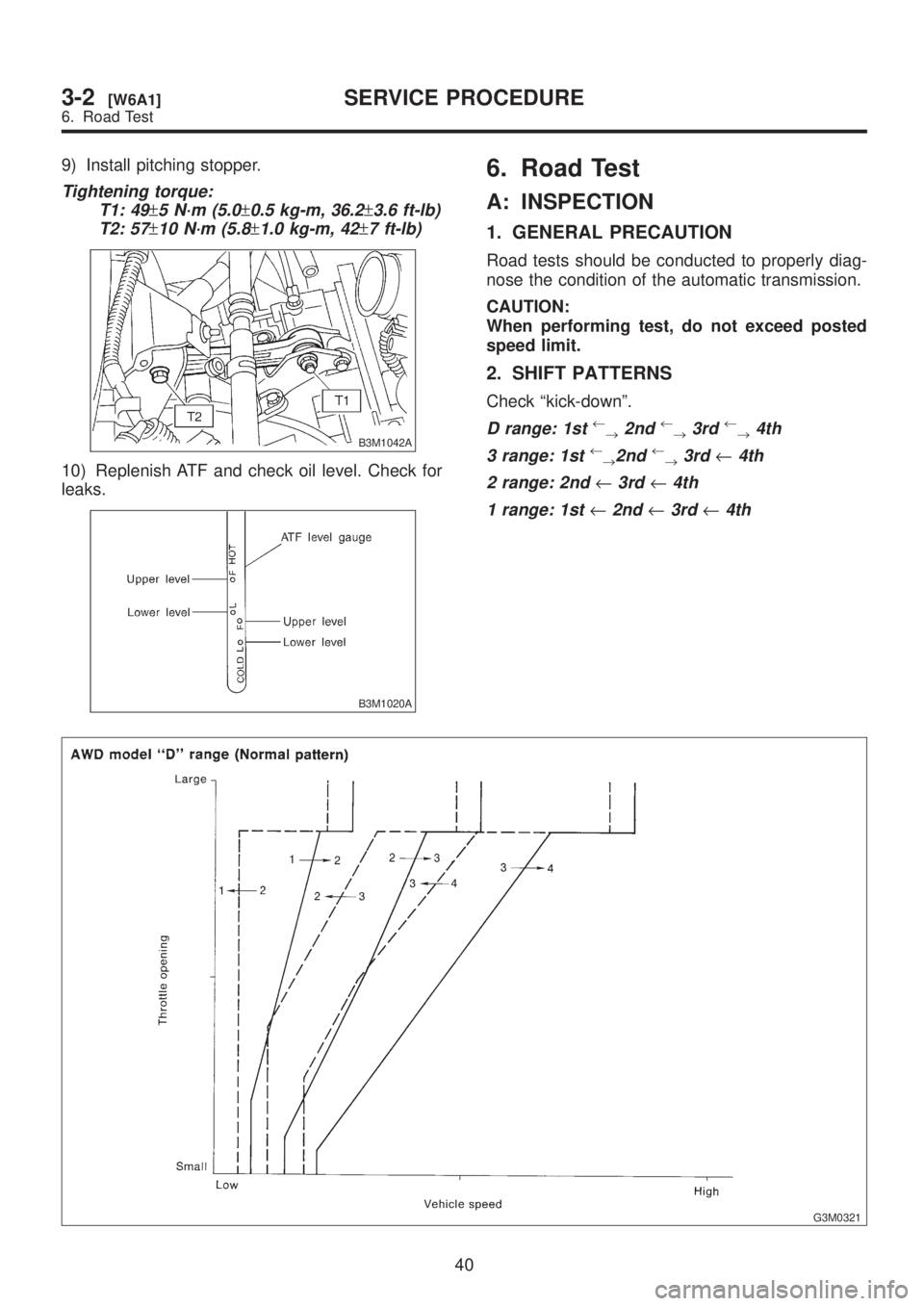
9) Install pitching stopper.
Tightening torque:
T1: 49
±5 N´m (5.0±0.5 kg-m, 36.2±3.6 ft-lb)
T2: 57
±10 N´m (5.8±1.0 kg-m, 42±7 ft-lb)
B3M1042A
10) Replenish ATF and check oil level. Check for
leaks.
B3M1020A
6. Road Test
A: INSPECTION
1. GENERAL PRECAUTION
Road tests should be conducted to properly diag-
nose the condition of the automatic transmission.
CAUTION:
When performing test, do not exceed posted
speed limit.
2. SHIFT PATTERNS
Check ªkick-downº.
D range: 1st¬
®2nd¬
®3rd¬
®4th
3 range: 1st
¬
®2nd¬
®3rd¬4th
2 range: 2nd
¬3rd¬4th
1 range: 1st
¬2nd¬3rd¬4th
G3M0321
40
3-2[W6A1]SERVICE PROCEDURE
6. Road Test
Page 567 of 1456
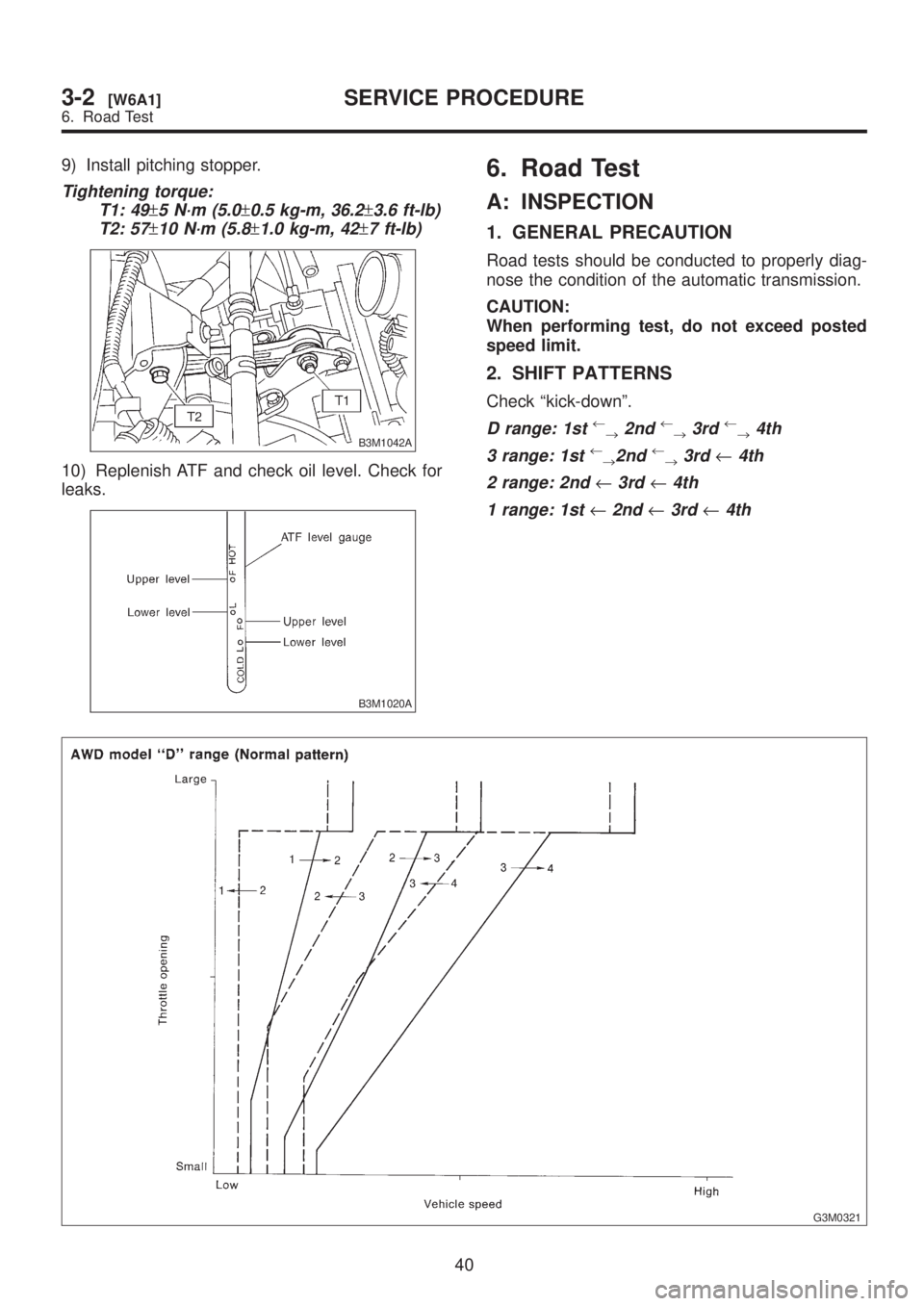
9) Install pitching stopper.
Tightening torque:
T1: 49
±5 N´m (5.0±0.5 kg-m, 36.2±3.6 ft-lb)
T2: 57
±10 N´m (5.8±1.0 kg-m, 42±7 ft-lb)
B3M1042A
10) Replenish ATF and check oil level. Check for
leaks.
B3M1020A
6. Road Test
A: INSPECTION
1. GENERAL PRECAUTION
Road tests should be conducted to properly diag-
nose the condition of the automatic transmission.
CAUTION:
When performing test, do not exceed posted
speed limit.
2. SHIFT PATTERNS
Check ªkick-downº.
D range: 1st¬
®2nd¬
®3rd¬
®4th
3 range: 1st
¬
®2nd¬
®3rd¬4th
2 range: 2nd
¬3rd¬4th
1 range: 1st
¬2nd¬3rd¬4th
G3M0321
40
3-2[W6A1]SERVICE PROCEDURE
6. Road Test
Page 568 of 1456
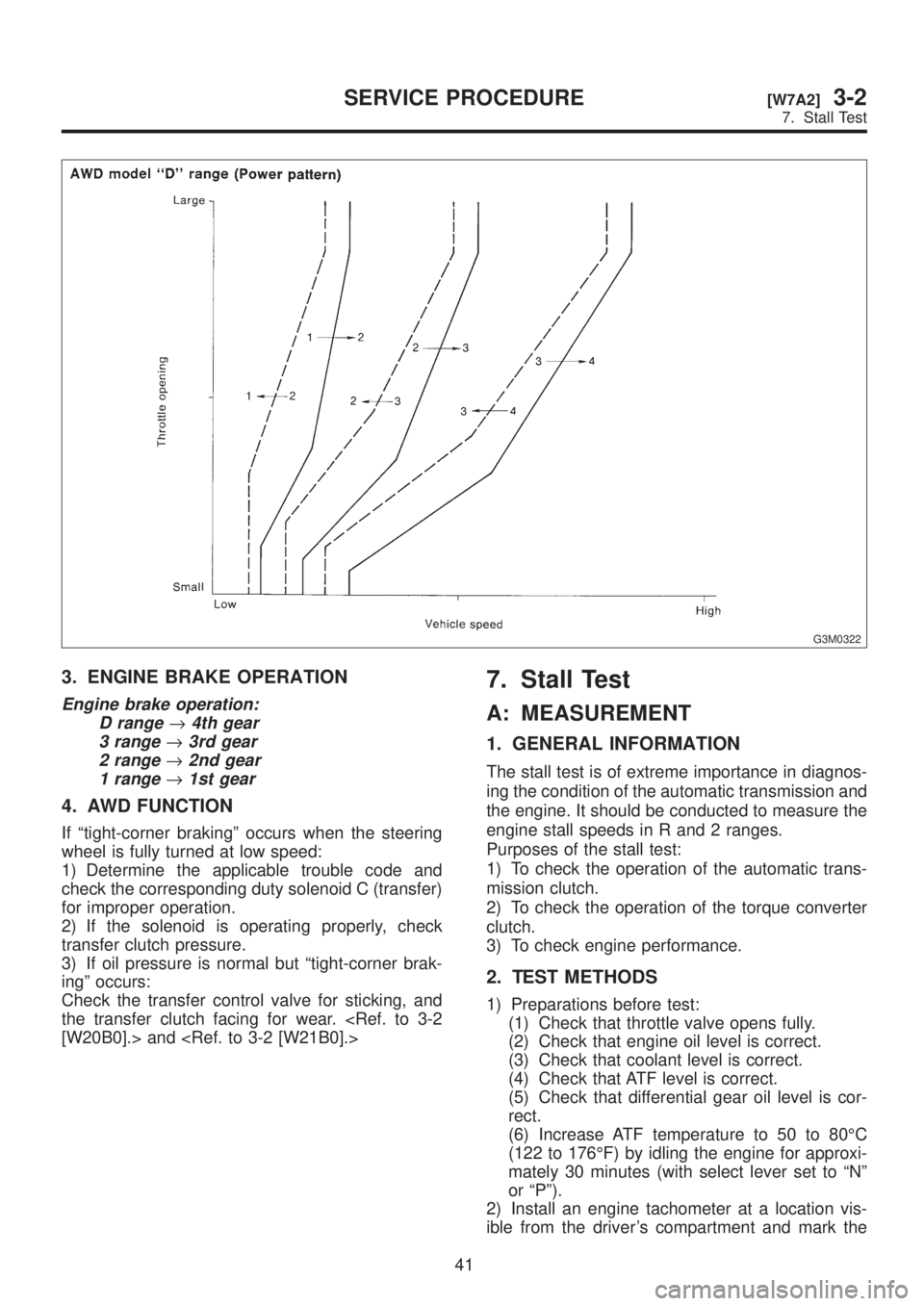
G3M0322
3. ENGINE BRAKE OPERATION
Engine brake operation:
D range
®4th gear
3 range
®3rd gear
2 range
®2nd gear
1 range
®1st gear
4. AWD FUNCTION
If ªtight-corner brakingº occurs when the steering
wheel is fully turned at low speed:
1) Determine the applicable trouble code and
check the corresponding duty solenoid C (transfer)
for improper operation.
2) If the solenoid is operating properly, check
transfer clutch pressure.
3) If oil pressure is normal but ªtight-corner brak-
ingº occurs:
Check the transfer control valve for sticking, and
the transfer clutch facing for wear.
7. Stall Test
A: MEASUREMENT
1. GENERAL INFORMATION
The stall test is of extreme importance in diagnos-
ing the condition of the automatic transmission and
the engine. It should be conducted to measure the
engine stall speeds in R and 2 ranges.
Purposes of the stall test:
1) To check the operation of the automatic trans-
mission clutch.
2) To check the operation of the torque converter
clutch.
3) To check engine performance.
2. TEST METHODS
1) Preparations before test:
(1) Check that throttle valve opens fully.
(2) Check that engine oil level is correct.
(3) Check that coolant level is correct.
(4) Check that ATF level is correct.
(5) Check that differential gear oil level is cor-
rect.
(6) Increase ATF temperature to 50 to 80ÉC
(122 to 176ÉF) by idling the engine for approxi-
mately 30 minutes (with select lever set to ªNº
or ªPº).
2) Install an engine tachometer at a location vis-
ible from the driver's compartment and mark the
41
[W7A2]3-2SERVICE PROCEDURE
7. Stall Test
Page 569 of 1456
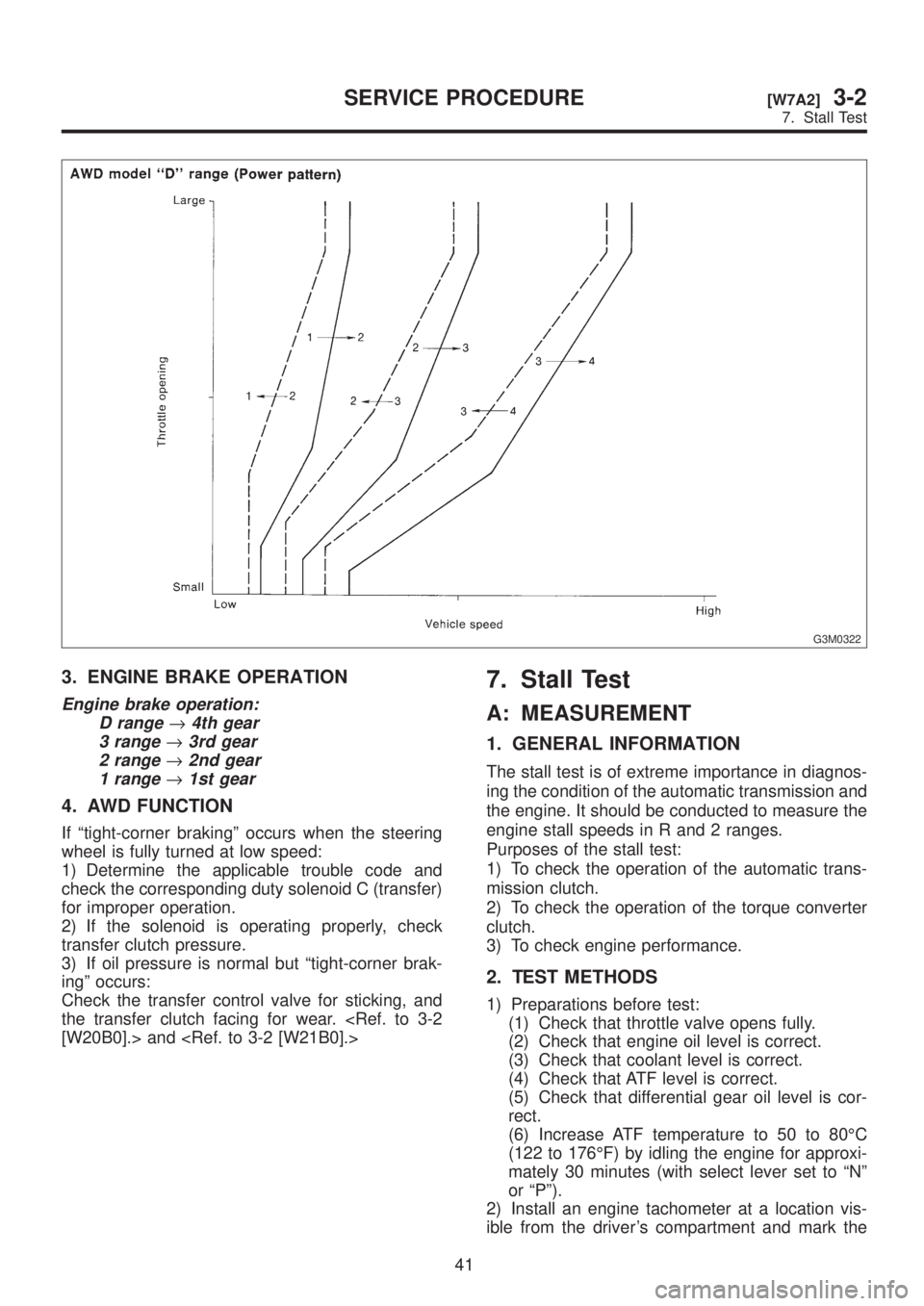
G3M0322
3. ENGINE BRAKE OPERATION
Engine brake operation:
D range
®4th gear
3 range
®3rd gear
2 range
®2nd gear
1 range
®1st gear
4. AWD FUNCTION
If ªtight-corner brakingº occurs when the steering
wheel is fully turned at low speed:
1) Determine the applicable trouble code and
check the corresponding duty solenoid C (transfer)
for improper operation.
2) If the solenoid is operating properly, check
transfer clutch pressure.
3) If oil pressure is normal but ªtight-corner brak-
ingº occurs:
Check the transfer control valve for sticking, and
the transfer clutch facing for wear.
7. Stall Test
A: MEASUREMENT
1. GENERAL INFORMATION
The stall test is of extreme importance in diagnos-
ing the condition of the automatic transmission and
the engine. It should be conducted to measure the
engine stall speeds in R and 2 ranges.
Purposes of the stall test:
1) To check the operation of the automatic trans-
mission clutch.
2) To check the operation of the torque converter
clutch.
3) To check engine performance.
2. TEST METHODS
1) Preparations before test:
(1) Check that throttle valve opens fully.
(2) Check that engine oil level is correct.
(3) Check that coolant level is correct.
(4) Check that ATF level is correct.
(5) Check that differential gear oil level is cor-
rect.
(6) Increase ATF temperature to 50 to 80ÉC
(122 to 176ÉF) by idling the engine for approxi-
mately 30 minutes (with select lever set to ªNº
or ªPº).
2) Install an engine tachometer at a location vis-
ible from the driver's compartment and mark the
41
[W7A2]3-2SERVICE PROCEDURE
7. Stall Test
Page 570 of 1456
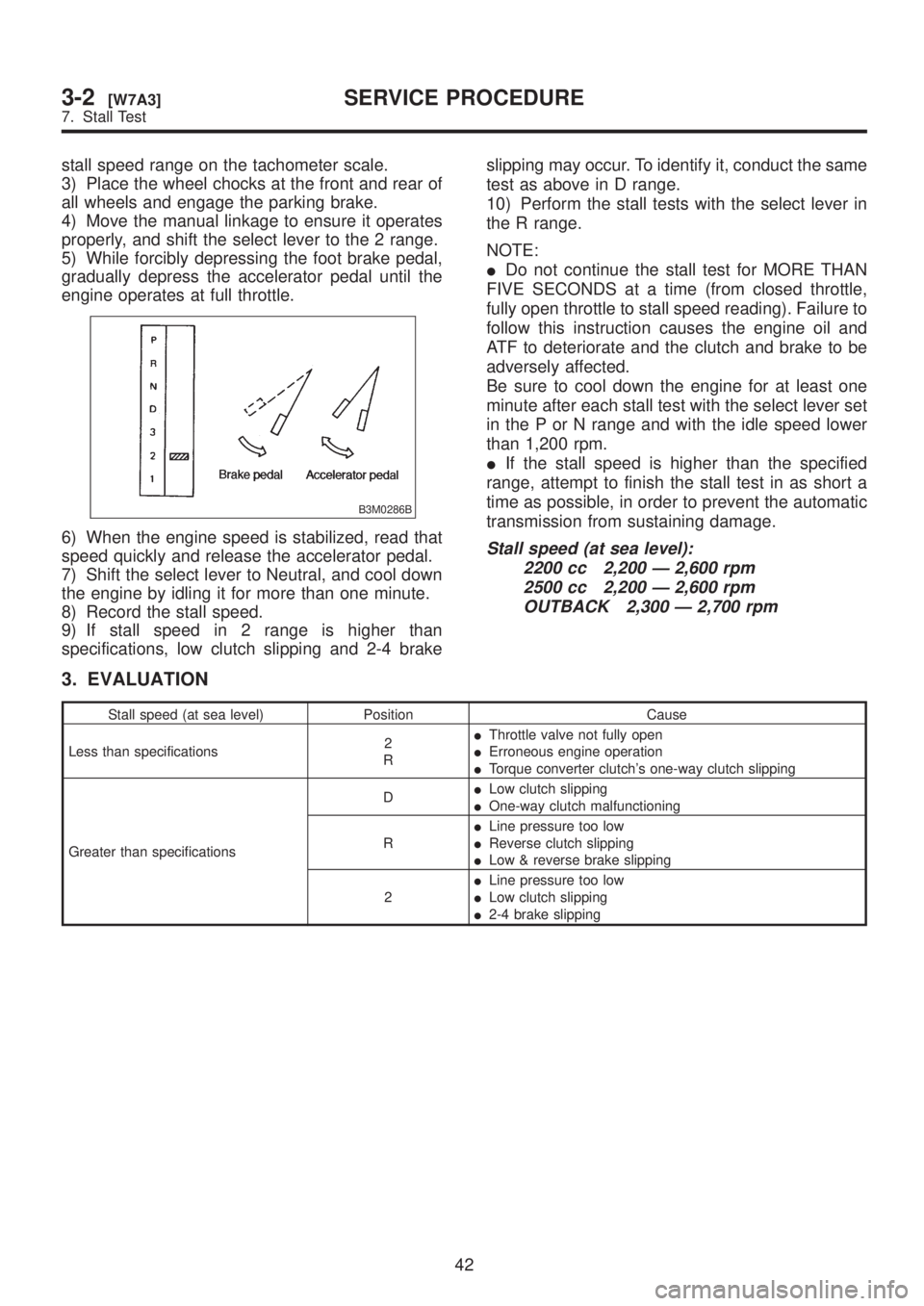
stall speed range on the tachometer scale.
3) Place the wheel chocks at the front and rear of
all wheels and engage the parking brake.
4) Move the manual linkage to ensure it operates
properly, and shift the select lever to the 2 range.
5) While forcibly depressing the foot brake pedal,
gradually depress the accelerator pedal until the
engine operates at full throttle.
B3M0286B
6) When the engine speed is stabilized, read that
speed quickly and release the accelerator pedal.
7) Shift the select lever to Neutral, and cool down
the engine by idling it for more than one minute.
8) Record the stall speed.
9) If stall speed in 2 range is higher than
specifications, low clutch slipping and 2-4 brakeslipping may occur. To identify it, conduct the same
test as above in D range.
10) Perform the stall tests with the select lever in
the R range.
NOTE:
IDo not continue the stall test for MORE THAN
FIVE SECONDS at a time (from closed throttle,
fully open throttle to stall speed reading). Failure to
follow this instruction causes the engine oil and
ATF to deteriorate and the clutch and brake to be
adversely affected.
Be sure to cool down the engine for at least one
minute after each stall test with the select lever set
in the P or N range and with the idle speed lower
than 1,200 rpm.
IIf the stall speed is higher than the specified
range, attempt to finish the stall test in as short a
time as possible, in order to prevent the automatic
transmission from sustaining damage.Stall speed (at sea level):
2200 cc 2,200 Ð 2,600 rpm
2500 cc 2,200 Ð 2,600 rpm
OUTBACK 2,300 Ð 2,700 rpm
3. EVALUATION
Stall speed (at sea level) Position Cause
Less than specifications2
RIThrottle valve not fully open
IErroneous engine operation
ITorque converter clutch's one-way clutch slipping
Greater than specificationsDILow clutch slipping
IOne-way clutch malfunctioning
RILine pressure too low
IReverse clutch slipping
ILow & reverse brake slipping
2ILine pressure too low
ILow clutch slipping
I2-4 brake slipping
42
3-2[W7A3]SERVICE PROCEDURE
7. Stall Test